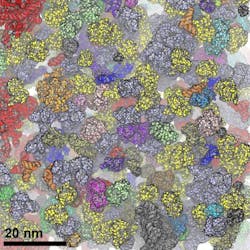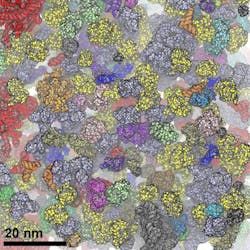Color-changing sensor, aided by light microscopy, demonstrates lack of space in living cells
Proteins and other biomolecules are often analyzed exclusively in aqueous solutions in test tubes. But it is uncertain if these experimental studies can be transferred to the densely packed cellular environment. Realizing this, researchers at Ruhr University Bochum (RUB) in Germany have designed a sensor that changes color, depending on how confined the space in a living cell is. Then, using light microscopy, they were able to analyze the effects of the lack of space in the cells.
Proteins fulfil a wealth of functions in a cell. Different proteins are responsible for structure formation, catalysis of chemical reactions, and transmission of cellular signals. Even the smallest protein defects can have grave consequences, as they can trigger diseases such as Alzheimer’s, Parkinson’s, or Huntington’s diseases. For the purpose of studies, proteins are frequently isolated from their natural environment and are analyzed in aqueous solutions. "It is often neglected that the cell environment is a densely packed matrix consisting of diverse macromolecules as well as small organic and inorganic substances, which make the cell interior very viscous and highly concentrated,” explains Dr. Simon Ebbinghaus, a junior professor at RUB who led the work. "This raises the question if analytic methods in aqueous solutions can truly reflect the natural behavior of proteins in the cellular environment."
In order to better understand these effects, the researchers used a polymer marked with dyes to fulfil the function of a sensor. Once it is compressed in the confined space, the dye pigments move closer together, and the frequency of the measured light changes under the microscope. “Observing the light, a change from green to red can be detected,” says Ebbinghaus.
Deploying different macromolecular additives (crowding reagents), which had previously been used to create a stipulated lack of space, the researchers demonstrated in the test tube that the sensor is fully functional and that it reacts very sensitively to a densely packed environment. Subsequently, they injected the sensor into living cells and were surprised: contrary to the expectations, it became apparent that a force exists inside the cell that pulls its compact form apart. This is evidence of attractive forces inside the cell that override the compression effects predicted in theory.
The researchers then put the cell under so-called osmotic stress by increasing the salt concentration in the environment. The cell reacted by releasing water—the result was in an even greater density inside. Such osmotic stress increased the cellular compression effects significantly.
“Such changes to the cellular environment can have drastic consequences and affect the protein functions in the long term,” explains Ebbinghaus. “Other forms of stress—for example, through unfolded or misfolded proteins which amass in a certain region of the cell—could change the cellular environment significantly. Such changes may promote protein clumping, which play a crucial role in the generation of neurodegenerative diseases.”
Full findings appear in the journals Angewandte Chemie and Angewandte Chemie International Edition.
-----
Follow us on Twitter, 'like' us on Facebook, connect with us on Google+, and join our group on LinkedIn
Subscribe now to BioOptics World magazine; it's free!

